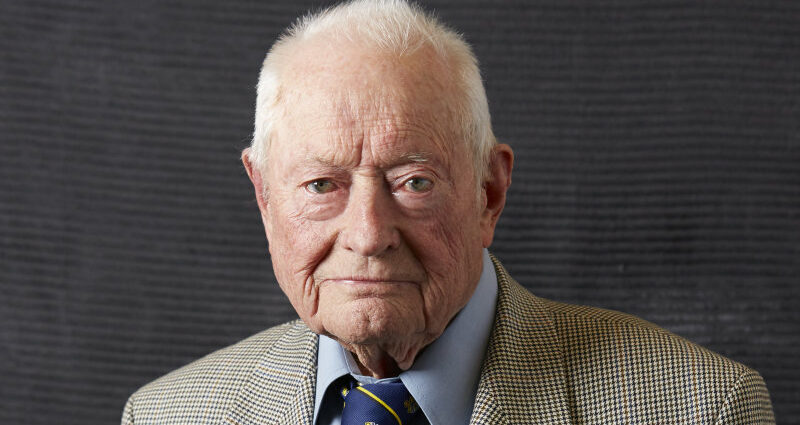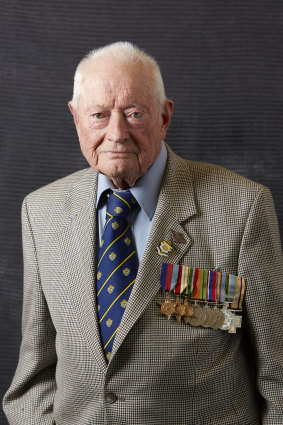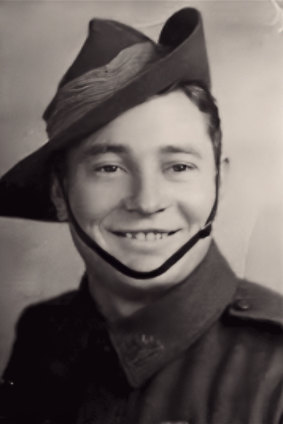Save articles for later
Add articles to your saved list and come back to them any time.
Tom Pritchard, 102, is the last man left standing – the last of the legendary Australian Rats of Tobruk alive.
Tom Pritchard, the last living Rat of Tobruk.Credit: Liza-Jayne Lyons/AWM 2017.520.1.1975
The saga of the Rats is extraordinary, perhaps the greatest in Australia’s military history. In April 1941, the situation was more than merely grim for the Allies. The forces of Adolf Hitler had already rolled through continental Europe, knocking over every army that opposed it. Using the tactic of blitzkrieg – lightning offensive movement by land and air, using artillery, infantry, tanks and planes to break through enemy weak points and sow havoc – they seemed unstoppable. When Italy joined the war on the side of the Germans in June 1940, Mussolini’s forces in North Africa threatened the Suez Canal and Australian forces were dispatched to secure the key Italian-held port of Tobruk in Libya to deny the Axis forces an obvious supply point in any mass eastern sweep to Egypt.
The Australians attacked Tobruk on January 21, 1941, with the loud cry from a lieutenant of the 2/1st Pioneers shattering the pre-dawn stillness: “Go, you bastards!”
And go those bastards did, overwhelming Italian positions after bitter fighting. A day later, the cable came from Cairo asking how many Italian prisoners there were, and the answer from the Australians made it into the official report given to British Prime Minister Winston Churchill: “20 acres of officers and 100 acres of other ranks!”
Which was one thing. Holding it from the forces of General Erwin Rommel’s Afrika Korps, now sent by Hitler to take back Tobruk, was another. Nothing had stopped the brilliant Rommel to this point. It was for Australia’s General Sir Leslie Morshead, commander of the fortress, to organise his initial forces – Australian infantry on the perimeter, British artillery on the inside – to withstand Rommel’s devastating Panzer tanks, infantry, artillery and Stuka bombers. The key was to dig in, to effectively live underground to be able to withstand the bullets, bombs and shelling, and only come out to repel enemy attacks.
Tom Pritchard in uniform.Credit: Rats of Tobruk
The first battle royale took place in the early hours of April 14, 1941, as the Afrika Korps attacked en masse, their tanks rumbling forward, with the infantry behind – attacking positions already shelled by artillery. Of course there were casualties, and driver Tom Pritchard VX23441 – a young man from Portland, Victoria, whose father had fought in the famous battle of Hill 60 in the First World War – was one of those in the thick of it with the stretcher bearers of the 2/5th Field Ambulance rushing his fellow Diggers to aid stations. Some men were missing limbs. Bathed in blood, the stretcher bearers did their work, knowing that at any moment they risked being engulfed by Rommel’s forces. But the most amazing thing happened.
When the smoke had cleared, the Afrika Korps had retreated. Sixteen of Rommel’s tanks had been destroyed. For the first time in World War II the German army had been stopped.
Few could believe it, least of all the British traitor and propagandist Lord Haw-Haw, who broadcast from Berlin shortly afterwards that Tobruk was now being held by “the sons of sheep herders”, these “self-supporting prisoners of war” who were now surrounded by the mighty German and Italian armies, and were caught like “rats in a trap”.
“These rats of Tobruk,” he infamously sneered. “Living like rats, they’ll die like rats.”
The Diggers reeled. Looked at each other. Laughed. The “rats of Tobruk”! They loved it. It was perfect. In fact, make that the “Rats of Tobruk” with a capital “R”, as in “Rommel defeated”!
The Australians and their allies continued to hold back the Germans in succeeding months, with Pritchard among those constantly going out under fire to rescue and provide succour to the wounded.
In awe of what they were achieving, the great ABC correspondent Chester Wilmot wrote the immortal words on site that were subsequently broadcast throughout Australia.
“The spirit which has made Australia is the spirit which has held Tobruk,” he typed. “The inspiring and binding force in Australian life isn’t tradition or nationalism or social revolution. It’s quite a simple thing. Henry Lawson called it MATESHIP … the spirit which makes men stick together. In Australia, by sticking together, men have defied drought, bushfire and flood. In Tobruk they’ve scorned hardship, danger and death, because no Digger would ever let his cobbers down. In Tobruk, for the first time in this war, the Germans were thrust back by a spirit that even tanks and dive-bombers could not conquer.”
By the time the last of the Australians were pulled out in December, 15,000 Australians were proud to call themselves a “Rat of Tobruk”, and the mateship endured for the next 80 years and more. Pritchard – who after service in North Africa also boasted service in the famous New Guinea battle of Shaggy Ridge, among others – settled down with his new bride Gwen. He worked with Victoria’s State Electricity Commission, and together they raised four children, settling in Dandenong. Described by the secretary of the Rats of Tobruk Association, Lachlan Gaylard, as “a low-key larrikin,” Pritchard was a member of the Rats Committee for many years and loved catching up with fellow Rats at Tobruk House, in Melbourne’s Albert Park. Six months ago, there were half-a-dozen of them left.
Two weeks ago, the second-last one died.
Pritchard really is now the last Rat left standing, according to the Rats of Tobruk organisation – though he is now more often lying down in a Melbourne rehab facility, after a fall last week has given him a “crook hip”.
Though I am holding out hope of “maybe a chat in two months”, he has declined a formal interview for the moment, saying cheerily, via an intermediary, “I do not want to be made a martyr. Tell him to look up some of the blokes who died, and write about them.”
The Sydney Morning Herald and The Age respect his wishes. But we offer our warmest regards regardless, and our profound respect to all the fallen Rats, and to Tom Pritchard personally: the last one left to hold their banner high.
In the case of Pritchard, Lord Haw-Haw got it wrong by 82 years.
Peter FitzSimons published Tobruk in 2008.
The Morning Edition newsletter is our guide to the day’s most important and interesting stories, analysis and insights. Sign up here.
Most Viewed in National
From our partners
Source: Read Full Article
-
Brit, 20, dies after cops pulled his body from the sea near popular beach on holiday island of Mallorca | The Sun
-
Beijing and Moscow vow to deepen military ties
-
I'm haunted by teacher abuse – it was like being tossed about like by a ragdoll, Nicky Campbell tells inquiry | The Sun
-
Health Secretary Steve Barclay hit with bullying allegations
-
Horror moment top Russian parachutist plunges to his death in skydiving event to mark Putin’s 71st birthday | The Sun



